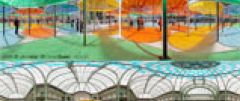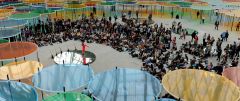© Daniel Buren, ADAGP, Paris
An architecture based on the circle
MS: Now you have found the solution and in a few weeks you will see the first technical tests on full scale prototypes. How was the project developed from the start?
DB: The breakthrough came when I finally realised that this iron and glass architecture was based on the circle and the main tool used to design the building was a compass. So I made dozens and dozens of sketches. These drawings were the starting point for discussions with Patrick Bouchain and Loïc Julienne, and with Jean-Louis Froment, whom I had asked to help in the very early phase of the project.
We launched into a game of ping pong: sketches, discussions, exchanges, new sketches, improvements, discussions, a complete change of approach, new sketches, discussions, and so it went on.
Then after bouncing all these very different projects back and forth, we decided to take a decisive step and choose one of them, still in the early stages. I jumped in the deep end and the architects made a model so we could grasp the scale of the place, understand its gigantic proportions and try to see the relationship needed with the elements in my budding project.
That is when we decided on the proportions. The most important thing for me was the confrontation between a device placed quite low down – a sort of ceiling made of hundreds of clear, coloured circles – and the great height of the nave of the Grand Palais. I expected this extreme tension to emphasise not the hugeness of the building but its volume, left as empty as possible. As if to give shape to the air circulating in it.







 Daniel Buren, Photo-souvenir : Esquisse graphique pour Monumenta
Daniel Buren, Photo-souvenir : Esquisse graphique pour Monumenta